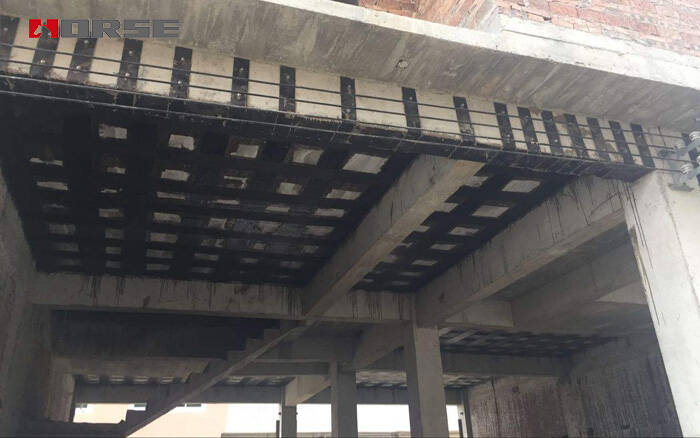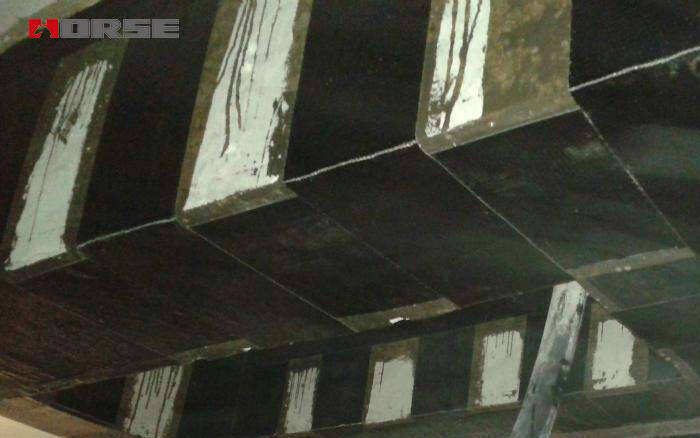Solutions
Horse Construction offers full range of structural strengthening materials with technical supports, documentation supports, products supports, project supports.
How Does Reinforcement Design Ensure Structural Stability

Structural stability is one of the most important control elements for the overall safety of a building. A number of controls must be done at the design stage. The structure with insufficient stability can be reinforced and earthquake-resistant calculations can be carried out. The specific precautions are as follows:
Design element control
1. Seismic level and air defense level;
2. Foundation treatment and foundation bearing capacity, foundation design grade;
3. Raw material quality requirements;
4. Snow load and wind load;
5. Groundwater type and elevation, foundation waterproof and anti-leakage design;
6. Judgment of the type of foundation soil.
Frame shear structure design
1. Analyze the beam-column and rigid or hinged bearing system, and review it according to the design load.
2. The overall performance of the building structure is better when the cast-in-place beams, columns, and floor structures are used, and the seismic capacity is higher. If the prefabricated design is adopted, the quality and connection performance of the prefabricated component assembly nodes must be strengthened, and comparisons should be made according to the seismic and waterproof requirements.
Frame structure optimization
1. Reasonably optimize the stirrup spacing of frame beams and columns, and classify and arrange the minimum stirrup diameter and maximum stirrup spacing of the stirrup densification zone according to the different seismic grades of beams and columns.
2. In combination with material characteristics, review the structural foundation design grade and masonry structure quality control, and review the rationality of the structural design in combination with the type of foundation soil.
Steel structure stability control
1. According to the ratio of the thickness to the length of the member, design the member with strong stability to ensure that the stability and strength of the steel member can reach the standard.
2. When designing, the overall building should be arranged symmetrically to avoid excessive deviation of the center of gravity.
3. If the component buckles before the overall structure fails, the overall bearing capacity of the component must be increased through the buckling strength of the steel component.

Structural reinforcement
1. When using enlarged section reinforcement method or restraint reinforcement method, ensure that the concrete strength level is not lower than C10.
2. When sticking steel reinforcement method or sticking fiber composite reinforcement method is adopted, the concrete strength grade should not be lower than C15.
3. When using the prestressed reinforcement method, the concrete strength grade should not be lower than C30.
4. When the cantilevered structure adopts the reinforcement technology to connect the components, the concrete strength level of the implanted components should not be lower than C25.
5. When the masonry structure is reinforced, it must be inspected on site to determine that the strength of the mortar of the reinforced wall is not lower than M5.
6. When adding concrete structural columns, ring beams and other reinforcement measures to improve the structural integrity, the mortar strength level must be determined to be no less than M5.
Structural seismic check
1. Based on the seismic action, the representative value of gravity, the seismic influence coefficient, the combination of seismic action effects, etc., the building is checked against earthquakes, and reviewed according to the fortification intensity. At the same time, it is also necessary to review whether the overall building meets the original use functions.
2. For buildings that are only subjected to seismic reinforcement or partial reconstruction, seismic deformation check calculations are not required. If storeys are added, the seismic deformation check calculations must be performed.
3. For buildings whose design service life does not exceed 25 years after structural reinforcement, the seismic adjustment coefficient of bearing capacity can be taken as 0.85 times the value specified in the code.
4. When the change of the structural stiffness and the representative value of gravity after reinforcement are less than 10% and 5% respectively, the influence of changes in seismic action may not be included. If the original structural system is changed, the overall seismic recheck calculation of the structure must be carried out according to the actual situation after reinforcement.
You can find anything here you are in need of, have a trust trying on these products, you will find the big difference after that.

High strength, unidirectional carbon fiber wrap pre-saturated to form a carbon fiber reinforced polymer (CFRP) wrap used to strengthen structural concrete elements.

High strength carbon fiber reinforced polymer (CFRP) strip / laminate / plate for structural strengthening and concrete repair

Prestressed carbon fiber reinforced polymer(CFRP) plate for slab, beam strengthening to increase stiffness, reduce distortion and deflection of members, reduce the cracks, avoid and stop cracking.